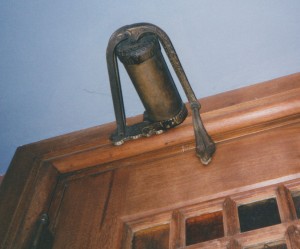 All the discussion about the unidentified piece of antique hardware reminded me to create a post about the invention of the door closer. Luckily, the story of the original LCN door closer was written down in approximately 1937, and I have reproduced it in this post. This story is near and dear to my heart, since the door closer was invented at Boston’s Trinity Church, and I wrote the hardware spec for a large renovation there a few years back. The photo at right was taken about 10 years ago, and shows one of the original LCN closers at Trinity.
All the discussion about the unidentified piece of antique hardware reminded me to create a post about the invention of the door closer. Luckily, the story of the original LCN door closer was written down in approximately 1937, and I have reproduced it in this post. This story is near and dear to my heart, since the door closer was invented at Boston’s Trinity Church, and I wrote the hardware spec for a large renovation there a few years back. The photo at right was taken about 10 years ago, and shows one of the original LCN closers at Trinity.
The Story of the L.C.N. Door Closer – c. 1937
The Rector Wanted it Quiet!
A winter day in 1877, Boston’s splendid new Trinity Church was finished. Architect Richardson had done a noble piece of work, and so had Norcross Brothers of Worcester, who had the general contract. But there was one thing the eminent rector, Dr. Phillips Brooks, did not like. His first sermon in the new church had been punctuated, in nerve-wracking fashion, by a banging storm door out in front.
He spoke to the foreman about it, a capable young fellow, L.C.Norton by name, whom the Norcross people had left behind to watch things. Mr. Norton said he’d fix the door. Carefully he took off the door stops, shaved them down and installed rubber pads all around.
 But Dr. Brooks was far from satisfied. That constant “thump, thump” of the door was almost as bad as the banging. Both he and the congregation were very much annoyed! A bit of the rector’s famous eloquence was turned upon the unlucky foreman.
But Dr. Brooks was far from satisfied. That constant “thump, thump” of the door was almost as bad as the banging. Both he and the congregation were very much annoyed! A bit of the rector’s famous eloquence was turned upon the unlucky foreman.
Disgusted that his efforts were not appreciated, Mr. Norton stripped off his overalls, threw them with his tools into the little closet under the stairs, and slammed the door!…That is, he meant to slam the door, but it didn’t slam. Puzzled, he tried again and again to slam it, but could not do so. The air confined in the small closet formed a cushion…
Hmm! A cushion of confined air…Why couldn’t he make such a cushion to cure that storm door?
L.C.Norton was not the kind to put off trying a good idea. Searching the stores, he found a small hand-operated water pump*. He removed the hose and valves from the lower end and closed it with a cap of his own make having a hinge for attachment to the door. He then secured the handle end of the piston rod to a vertical post on the door jamb, drilled a few holes in the cylinder…and there it was: the first door check ever made!
L.C.Norton’s “Door Check” a Success from the Start
The Sunday after Mr. Norton had installed his new invention, Dr. Brooks had no cause to complain. Although late arrivals kept the storm door opening and shutting as usual, no sound from that source annoyed the good rector or his congregation. For the converted pump did its work, quietly and effectively, opposing the old-fashioned spring just enough to silence the closing of the door.
Dr. Brooks was delighted, and was one of the first to encourage Mr. Norton in the development of his invention.
The first step was to combine the closing and checking actions in one device, which meant putting a powerful spring into the checking cylinder. This change, with other modifications, resulted in the original “door check and spring” shown below, patented in 1880.
Mr. Norton interested a group of men in Boston and New York, who organized a company to manufacture and sell the device. One of the first customers was Trinity Church. Following his experience with the converted pump check, which had worked faithfully and well for more than a year, Dr. Brooks had sixteen of the new “check and spring” closers installed in the church. He was so well pleased by their performance that he wrote Mr. Norton the letter here reproduced.
Modern Door Control is the Outcome of 50 Years Experience in Meeting the Changing Needs of Progressive Designers and Builders
 Today door closers are taken for granted. Almost no building of consequence is without them. Modern privacy and comfort demand efficient, mechanical control of doors. Air-conditioned structures of all kinds, including railway trains, streamlined or standard, must have their exterior doors normally kept closed.
Today door closers are taken for granted. Almost no building of consequence is without them. Modern privacy and comfort demand efficient, mechanical control of doors. Air-conditioned structures of all kinds, including railway trains, streamlined or standard, must have their exterior doors normally kept closed.
But in 1880 the door closer was as much a novelty as the cotton-picking machine in 1936. It was unfamiliar to the architects of the day, and much more so to the general public. A great deal of missionary work had to be done. Mr. Norton’s enterprise had its difficulties, but he kept constantly at his work of improving the product, which attained wider and wider acceptance.
Advertising methods and media have changed much in half a century. Or have they? In 1889 Mr. Norton’s company put out a piece combining useful but irrelevant information, a bit of entertainment and some strong arguments for the “door check and spring.” This was a booklet listing the locations of the 874 fire alarm boxes in greater Boston. The inside front and back covers, not so different from what we see in today’s newspapers, are reproduced below.
Today…Mr. Norton’s finest achievements, the outcome of his 50 years experience, are embodied in the modern LCN Closer (right)
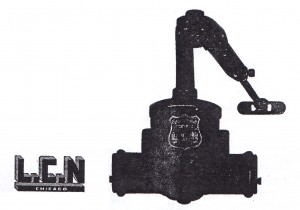 From the days of his first experiments in Trinity Church, L.C.Norton’s main interest has been door closers. For more than fifty years his inventive talents have been concentrated in this field. Having created the industry, his life has been devoted to its upbuilding, to constant improvements of products and widening of their use in response to the changing demands of American architects.
From the days of his first experiments in Trinity Church, L.C.Norton’s main interest has been door closers. For more than fifty years his inventive talents have been concentrated in this field. Having created the industry, his life has been devoted to its upbuilding, to constant improvements of products and widening of their use in response to the changing demands of American architects.
Norton Lasier Company Formed
In 1926, Mr. Norton and D.R. Lasier, who had been associated in business for many years, formed the Norton Lasier Company to manufacture a new “leakproof” door closer combining the best principles of former models with certain more advanced ideas. To their product they gave the name “L. C. N.”, utilizing Mr. Norton’s initials. The success of this standard surface type closer, pictured above, has been little short of phenomenal.
Answering the modern demand for concealment of mechanical devices in building construction, the Norton Lasier Company produced four superior types of closer for floor installation, which relieved the closer from carrying the door’s weight and provided for single or double action, for mounting on butts as well as on centered or offset pivots.
The Overhead Concealed Closer
In 1927 the company introduced a rather startling innovation, a practical, efficient closer concealed above the door in the head jamb. This closer has met with an enthusiastic reception on the part of architects and builders, who have seen its great advantages and found that its performance measures up to all requirements.
This company, following its founder’s ideals, has dedicated its entire time and resources to doing but one thing – producing the finest and most complete line of door control devices it is possible to create. How well is it succeeding? The answer must be left to those who have had experience with products bearing the L.C.N. trade mark.
Norton Lasier Company
Manufactures of L.C.N. Overhead Concealed, Floor Concealed and Surface Type Door Closers – 466 West Superior Street, Chicago – Sales and Service Representatives in 22 Cities
*Another account of the invention of the door closer, in Lewis C. Norton’s own words, states that his original design was based on a beer pump.
If you enjoy this blog, you can subscribe to receive an email each time a new post is published. The link is in the sidebar. —>
You need to login or register to bookmark/favorite this content.


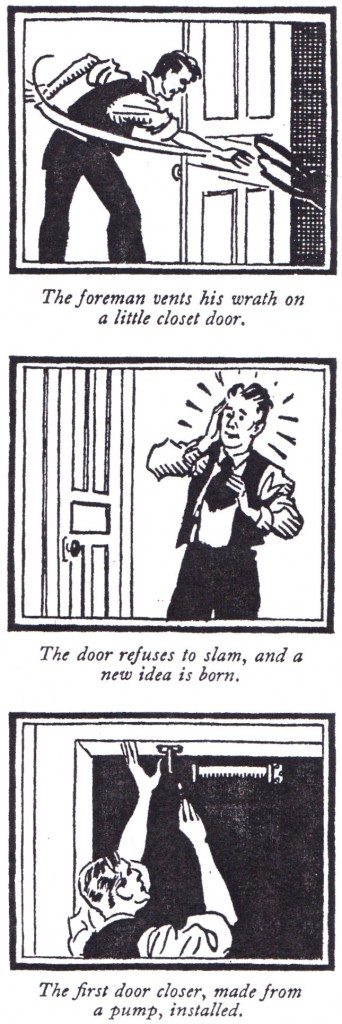
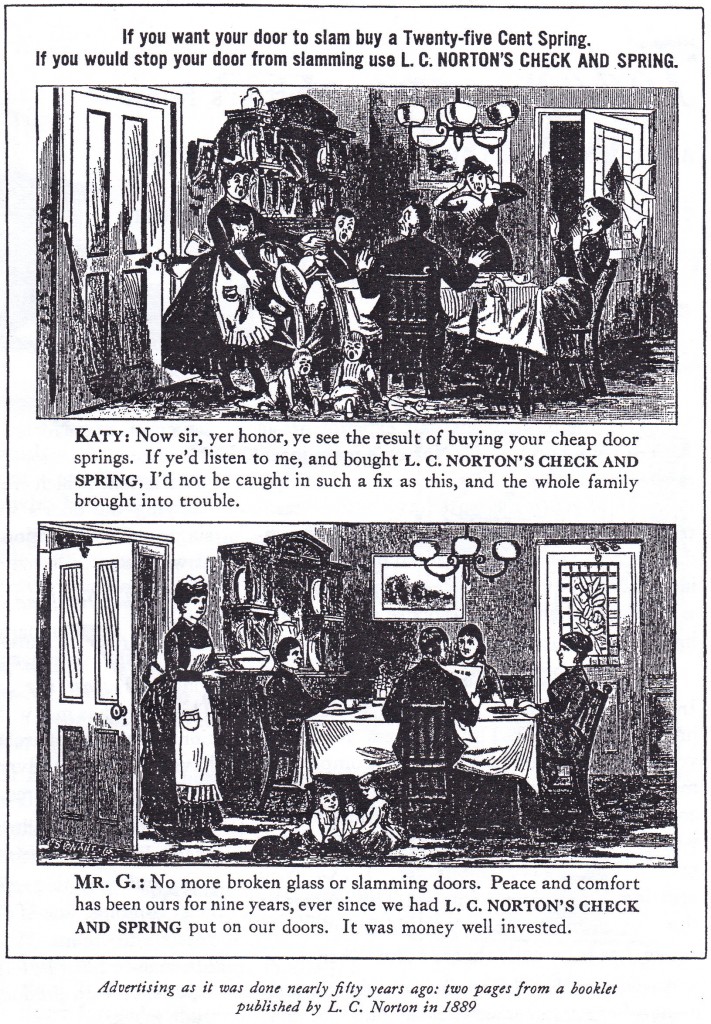



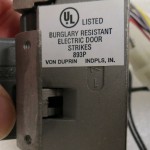
Lori,
I somehow had a feeling this would be next, GREAT FIND AT TRINITY CHURCH!!!!
first time I seen one on the door that was not sketch or drawing or patent drawing, I have seen these rarely on eBay as well, a few times bid but lost to people who resold at local estate sales or flea markets.
last I remember hearing about the original LCN closers, one was presented to a door closer factory in Monroe, NC(brand is not IR product, but product does bear the last name of inventor.
I like how you included the whole story of the closer, last time I read it to that depth of extent, was when LCN had it on the history pages back in 2001/2002.
I had a feeling the first LCN was just like a screen/storm door closer but on a larger scale, in fact the original one (first one installed on the church) I believe was actually intended for use as a beer pump, but then converted into a closer and installed on the door to stop slamming during services,
mr norton was a carpenter, many other closer makers were locksmiths.
the one in the picture, i cannot believe how great of condition it is in from being used all these years!!!! someone must really be taking care of them really well there
the first of the hydraulics (made starting in 1900’s) were the traditional/potbelly closers
that was a great pleasure to read and see the ads for the original LCN.
-Jess the door(closer)doctor
….can’t wait for those closer mechanics to see this one…….
Thanks Jess! I knew you’d like this post. 🙂
I forgot to add, that’s really cool that you wrote the hardware specs for Trinity during the renovation!!! do you know of any of the whereabouts of the other original LCN’s??
Did Yale make those pot closers too?
Yes Andy, several manufacturers made those closers – the potbelly style is actually still available and you can still find the old ones sometimes. It’s amazing how long they’ve been around. My daughter’s preschool still has tons of them.
– Lori
Lori, those things sure can outlive anything made these days, problem is, them new potbelly closers are not made of cast iron, they are of aluminum alloy.
Andy, there are only 2 brands left that make the traditional style closer, both are assa abloy products(and BKS in Germany makes them too) those things are in my places all over the world, including Sweden (Jernbolaget, Swedish for “the iron company” they no longer make them, stopped in the early 60’s I think) I have a friend who has 2 of them on the doors of her house, they are still functioning last time I asked about them.
I actually have one trad, a russwin from 1952. it’s taken a beating and still keeps working, mine, its fell off tables, been thrown across the room (my dad has a bad temper at times and took it out a few times on my closer) no damage yet to my closer from the times it’s fell or been thrown around, just goes to show how door-able(wordplay over with, durable)them things were back then!
only company I think that made them for the shortest time, was reading (now dorma)think they only made them for about 5 to 10 years, was between 70’s and 80’s, most companies stopped producing the cast iron traditional closers back in 1983 due to weight and cost of forging the metal and casting the closer body.
only difference between now and back then is the metal it’s made from and the adjustments, many of them early ones (from American hardware corp.)had a knurled knob instead of a hex key screw or slotted screw on the sides, (LCN has screws on both sides to adjust backcheck and sweep/latch) my russwin and my veterinarian’s closer has a knob instead of screws.
Lori, what brands of potbelly closers are seen in your daughter’s preschool?? and are they well maintained??
………love talking about geriatric closers……….those were the days of closers.. most of the questions I get about door closer problems are those about “geriatric” closers.
-Jess the door(closer)doctor
Hi Jess –
I’ll try to remember to get a photo of the closers at school. They’re still working, although they probably don’t get any maintenance.
– Lori
Just found a very early one of these in the loft of my car repair garage in the UK. We were fixing all types of transport right back to 1815, I think this one is one of the first models! A very ornate piece of history. …. Phill.
Hi Phil –
Would you send me some photos? I’d love to see the closer you found. lori.greene@allegion.com
– Lori
Hi Lori, I have an early one. Just sent you an email about it.
How interesting!
I just started working for a small Episcopal church and their number one complaint has been door closer issues.
Luckily I know how to fix them.